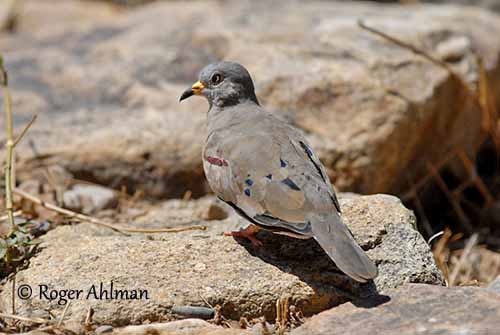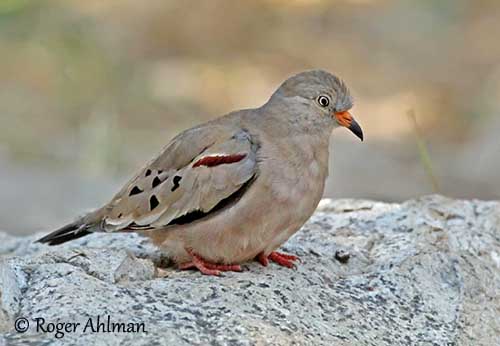
Fr: Colombe à bec jaune
Ang: Croaking Ground-Dove
All: Perutäubchen
Esp: Columbina Quiquagua - Tortolita Guiguagua - Tortolita Peruana
Ita: Tortora beccogiallo
Nd: Peruaanse Steenduif
Sd: Guldnäbbad markduva
Photographers:
Roger Ahlman
Pbase Galleries Peru and Ecuador
Didier Buysse
Vision d’Oiseaux
Jean Michel Fenerole
Photos d’Oiseaux du monde
And with the kind participation of Jean-Luc Juveneton
Text by Nicole bouglouan
Sources :
HANDBOOK OF THE BIRDS OF THE WORLD vol 4 by Josep del Hoyo-Andrew Elliott-Jordi Sargatal - Lynx Edicions - ISBN: 8487334229
PIGEONS AND DOVES by David Gibbs, Eustace Barnes and John Cox - Pica Press Sussex - ISBN: 1873403607
BirdLife International (BirdLife International)
Neotropical Birds – Cornell Lab of Ornithology
By Jack Clinton Eitniear
Breeding and diet of the Croaking Ground Dove - Columbina cruziana
By Johan Ingels and Harold F. Greeney
A comparative look at the nest and eggs of the Ecuadorian and Croaking Ground Doves (Columbina buckleyi and Columbina cruziana) in Ecuador
Croaking Ground-Dove
Columbina cruziana
Columbiformes Order – Columbidae Family
INTRODUCTION :
The Croaking Ground-Dove is an American ground-dove in the genus Columbina. These species are small, and males show brighter plumage than females.
This species occurs in arid and semi-arid areas along the Pacific coast of South America, from N Ecuador to N Chile. It is usually found on farmland, gardens and parks, and other vegetated areas. It can be seen up to 2400 metres of elevation. The breeding season is related to rainfalls.
The Croaking Ground-Dove is closely related to C. picui – Picui ground-Dove.
The English name comes from the male’s croaking call.

DESCRIPTION OF THE BIRD:
Biometrics:
Length: 15 cm
Weight: M: 52 g – F: 46 g
The adult male has brownish-grey upperparts, becoming darker on central rectrices. On the upperwing, the wing-coverts are pinkish-grey with blue-black spots. A wingbar is visible across the upperwing, formed by the purplish tips of some inner wing-coverts.
The underparts are mauve-pink, including the breast. On the tail, the outer rectrices are black with narrow white terminal band. Underwing-coverts and axillaries are blackish.
The head is bluish-grey. The fairly long bill is bright yellow to golden yellow near the base, whereas the tip is black and drooped. The eyes are red with a broad white outer ring, while the orbital skin is yellow. Legs and feet are reddish-pink.
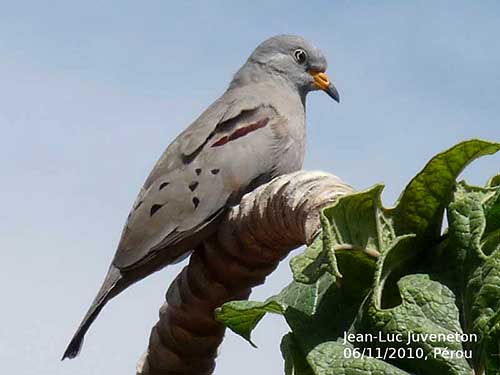
The female is usually greyer-brown on the upperparts, and fawn-brown on the underparts, without the mauve-pink wash. The wing pattern is less intense than in male.
On the head, the forehead is pale greyish-brown, grading to fawn-brown on hindneck, mantle and back.
The juvenile resembles female but the upperparts show fringed-buff feathers.

RANGE:
The Croaking Ground-Dove is found along the Pacific coast of South America, from extreme SW Colombia and N Ecuador, S to N Chile, and E in N Peru to Marañón Valley.
HABITAT:
The Croaking Ground-Dove frequents semi-humid to arid habitats up to 2400 metres of elevation. This species occurs in arid scrub and light dry deciduous woodland with open understorey. It is also found in open hilly country with sparse vegetation and in cultivated areas.
In N Peru, it frequents arid scrub with cacti and acacia scrub, but also suburban parks and gardens.
The Croaking Ground-Dove is able to adapt to habitat changes and can live in urban areas, road sides, industrial and agricultural sites.
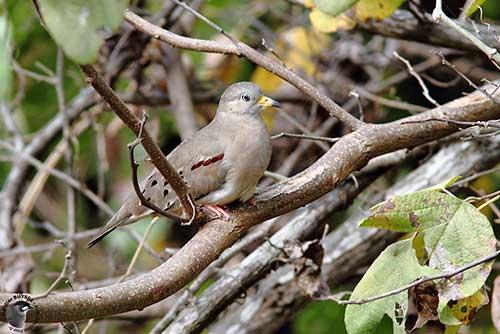
CALLS AND SONGS: SOUNDS BY XENO-CANTO
The Croaking Ground-Dove utters irregular, quiet croaking calls “weeoop” or “rreeeop” and “rroowp”. We can also hear some soft grunts and growls.
The male’s croaking call is given from low perch or even from the ground. The throat feathers are fluffed out while the bird is calling.

BEHAVIOUR IN THE WILD:
The Croaking Ground-Dove feeds on the ground and usually in large groups. The birds are often scattered across a wide area rather than together in flock.
It feeds on grass seeds from numerous plant species. Seeds are swallowed whole and their size is related to bill and gape size. From an observation, it feeds on seeds from about 120 plant species, but it favours small seeds, up to 2,5 millimetres in length.
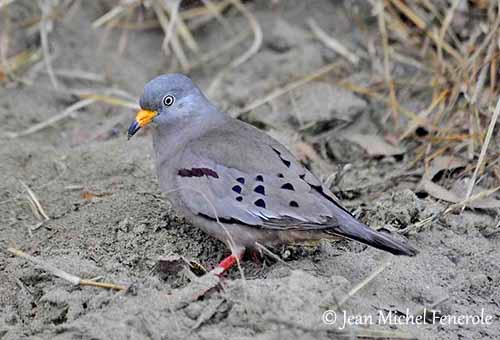
The breeding season is closely related to the wet season. In Ecuador this species breeds in all months except September and October, whereas in Peru, it breeds all year round.
The commonest courtship display consists of mutual preening, with the male pecking tenderly the head of the female. It often calls from low perch or from the ground all day long.
The displays are typical of Columbidae, including bowing in front of the female with drooped wings and sometimes raised tail, while bobbing the head.
Some aggressive interactions may occur between two males. They use the wings to strike the opponent. This type of dispute occurs on the ground.
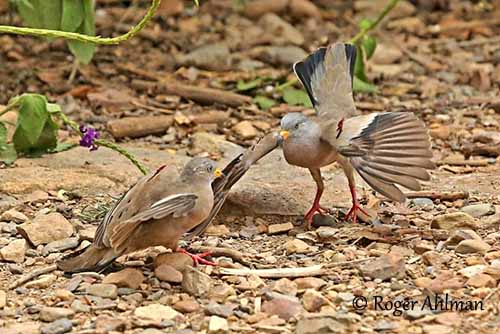
The Croaking Ground-Dove is resident throughout the range. The species is not known to make any significant movements.
It usually performs explosive take-off with noisy wingbeats, due to the broad, but short wings.
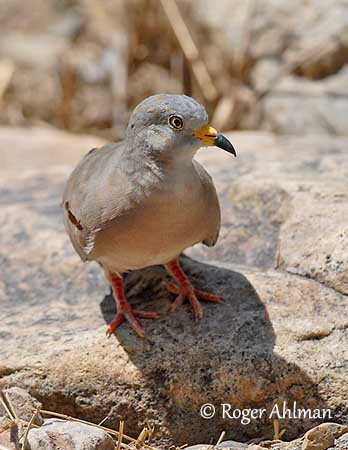
REPRODUCTION OF THIS SPECIES:
The breeding season starts 4-6 weeks after the first rainfalls, in December or early January.
Like all Columbidae, the Croaking Ground-Dove builds a fragile platform with twigs, sometimes lined with rootlets. It is placed in dense low shrub or on a ledge of cliff, wall or building, less than 20 metres above the ground.
The structure of the nest depends on the support. This is a flimsy platform on thick branch, whereas on finer branches and twigs, it is a more substantial platform-like structure.
The female lays two white eggs (1-3). The incubation lasts 14 days. The chicks are fed by both parents. After ten days, they may clamber into the vegetation or onto ledges. They fledge 10-13 days after hatching.
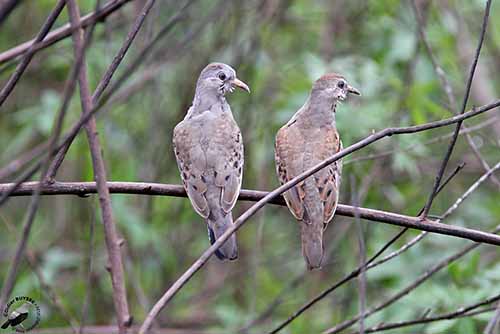
PROTECTION/ THREATS / STATUS:
The Croaking Ground-Dove is common to abundant throughout the range. The global population has not been quantified, but it is suspected to be increasing due to the creation of new areas of suitable habitats following habitat degradation.
The Croaking Ground-Dove is currently evaluated as Least Concern.
